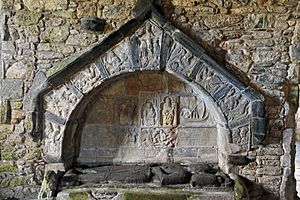St Clement's Church, Rodel facts for kids
Quick facts for kids St Clement's Church, Rodel |
|
|---|---|
| Native name Scottish Gaelic: Tùr Chliamhainn |
|

Saint Clement's church photographed from the pathway leading up to the main entrance
|
|
| Built | Early 16th Century |
| Built for | Alasdair Crotach MacLeod |
|
Listed Building – Category A
|
|
| Designated | 5 October 1971 |
| Reference no. | LB12912 |
| Lua error in Module:Location_map at line 420: attempt to index field 'wikibase' (a nil value). | |
St Clement's Church (called Tùr Chliamhainn in Scottish Gaelic, meaning Clement's Tower) is a very old church in Rodel, Harris, Scotland. It was built a long time ago, either in the late 1400s or early 1500s. This special church was made for the leaders, or Chiefs, of the MacLeods of Harris family. It is named after Pope Clement I. Sometimes people also call it Eaglais Roghadail or Rodal Church.
Contents
Building the Church: Architecture and Design
St Clement's Church was built using strong local rock called Lewisian gneiss. If you look at it from above, the church has a cross shape, which is called a cruciform plan.
At the west end of the church, there is a tall tower. You can get into this tower through a door from the main part of the church, called the nave. Then, you can climb up stone stairs and wooden ladders inside.
At the other end, the east end, you'll find the choir and the sanctuary. This is where the main altar used to be. A wooden screen once separated this area from the nave. On both sides of the nave, there are side sections called transepts, which have extra chapels. The main entrance door faces north and leads into the nave. The church's style of building looks like it was designed between 1520 and 1550.
Special Graves Inside
In 1528, a chief named Alasdair Crotach MacLeod had a magnificent tomb built for himself. It's on the south side of the choir. Many people think it's one of the most beautiful medieval wall tombs in all of Scotland. It has an arch over it and is decorated with carvings that tell stories from the Bible.
Alasdair's son, William, who became the 9th Chief, also had his grave prepared in 1539. It's in the south wall of the nave. There's also a third grave in the south transept, which probably belongs to John MacLeod of Minginish, the 10th Chief. You can also see five more grave slabs leaning against the wall in the north transept. Outside the church, in the graveyard, there are many more tombs belonging to the MacLeod family.
The Story of St Clement's Church
According to a writer named Dean Donald Munro, who wrote about the Western Isles in 1549, the church was built for the MacLeod Chiefs of Harris. These chiefs lived in Dunvegan Castle on the Isle of Skye. The church was likely built around 1520. While there's no clear proof, some believe there might have been an even older Celtic church on this spot before St Clement's.
Dean Munro called the church a "monastery." However, there's no sign that monks lived there. So, people think he meant it was a very important church for the local area, perhaps with a minister.
Changes Over Time
St Clement's was a Catholic church. But around 1560, soon after it was finished, it stopped being used. This happened because of a big change in Scotland called the Scottish Reformation, which changed how churches were run. Even though the church building wasn't used, the graveyard around it continued to be a burial place for the MacLeod family.
The church's roof fell apart over time. In 1784, Captain Alexander MacLeod of Berneray fixed it. But sadly, it burned down shortly after! So, it had to be rebuilt again in 1787. In the 1800s, the church was even used as a place to keep cows!
Later, in 1873, a woman named Catherine Herbert, the Countess of Dunmore, helped restore the church. Then, in 1913, the tower had to be rebuilt because it was damaged by a lightning strike six years earlier.
Today, St Clement's Church is looked after by Historic Scotland, an organization that cares for important historical places. It is also said that a famous poet from the 1600s, Mary Macleod (Mairi Nighean Alasdair Ruaidh), is buried here.


